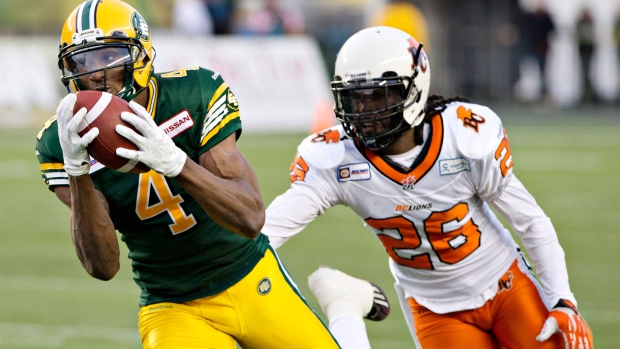Mar 31, 2015
Innovative CFL rule changes: it's about time
This year's CFL rules committee has voted in some very bold, aggressive rule change proposals - one of which, if passed by the Board of Governors, will become a real game changer. TSN football analyst Glen Suitor explains why limiting contact on a receiver to five yards of scrimmage will make a huge difference to the game.
By Glen Suitor

This year's CFL rules committee has voted in some very bold, aggressive rule change proposals - one of which, if passed by the Board of Governors, will become a real game changer.
When Glen Johnson, the Head of Officials in the CFL, took over last year he said in his opening press conference that he wanted to be "innovative" with the rules of the game. He intended to simplify some rule interpretations so that all stake holders in the game can better understand what is and isn't a penalty, but tried also to find new and innovative ways to improve the product.
The CFL rules committee has discussed the new proposed changes for months on conference calls, but March 25 in Toronto was the first of three days to discuss, debate and dissect the new proposals face to face. It was clear from the opening statements that this year the goal was to speed up the tempo of the game, and to increase the chance for explosive plays. The committee was determined to make it happen.
In the first meeting Johnson handed out a document to all the members of the committee that made it clear what the agenda was, with an opening statement that read:
"Guiding Principles for the proposed rule changes from Club Presidents and Governors:
• Improve the tempo and flow of the game
• Reduce the number of 'negative' stoppages including penalties
• Increase the opportunities for exciting plays and more scoring
• Simplify the rules of the game
• Be Innovative while protecting the integrity of the game"
There were eight proposed rule changes in the document and seven of the eight were eventually voted through to the next level. However, there is one in particular that if passed by the Governors will not only open up the game, but will satisfy every one of the goals and objectives set out by the league's Presidents and Governors.
Rule proposal 5 reads: Limit contact by a defender on a potential receiver to a zone of five yards of the line of scrimmage.
Objective: "Simplify the illegal Contact rule for everyone. Create more space on pass plays, create more exciting plays, and increase offence and scoring opportunities."
Quite simply, defensive backs and linebackers will no longer be able to contact a receiver after five yards. Incidental contact (hand fighting) will still be permitted, but a defender will no longer be able to jam a receiver at ten yards and stop or disrupt his progress.
It is a man-to-man cover technique (catch/squat technique) that is used by every team in the league effectively. A defensive back sits at between eight and twelve yards and waits for the receiver to close the distance. When the receiver gets close, the DB jams him, forcing him to restart or reroute, and in doing so, disrupts the timing between quarterback and receiver. It has been allowed under the premise that a defensive back has the right to defend his ground as long as he was square to the slot back or wide out. Under the new rule proposal this technique will no longer be permitted, and it is about time.
In the short term there will likely be more flags thrown for illegal contact as veteran defensive backs learn the new way to play, but in the long term in will improve the game tremendously. The analogy that can be used is when the NHL in 2005 decided there would be zero tolerance for hooking, holding, tripping, slashing and interference. Players were no longer allowed to use their stick to slow down the stars of the game.
For the first year or so, there were more hooking penalties in hockey but over the long term the behaviour changed, and the game opened up.
One of the issues of the catch technique by defensive backs has become they don't just jam a receiver at 10 yards, they are jamming him, then grabbing his shoulder pads or jersey and pulling at him for three or four more yards and sometimes worse. It has become sloppy football. Receivers getting mauled down the field is by no means up-tempo, fast football, in fact it starts to look more like wrestling.
Defensive backs can still be aggressive if they choose, but they would now have to do it at the line of scrimmage.
It is easy to see how this proposal will increase the speed and tempo of the game when you consider that receivers should have more room on a field that is 65 yards wide, and in a game that allows for unlimited motion towards the line of scrimmage.
While there may be more illegal contact penalties early, this rule change will simplify the penalty and will eventually lower the amount of pass interference and illegal contact penalties down field. It will take some of the judgment out of the hands of the refs.
There is no question the rule will open up the game and provide more opportunities for explosive plays, and scoring plays down field, and for those who are concerned about taking some of the contact out of a contact sport, don't worry. The integrity of the game is intact, and if a defensive back wants to be physical on a receiver, he can still do that - just not down the field.
The Board of Governors vote on April 8 and if it goes through, rule change proposal number 5 will change the game for the better.
It cleans the game up, it opens it up, and it's about time.



